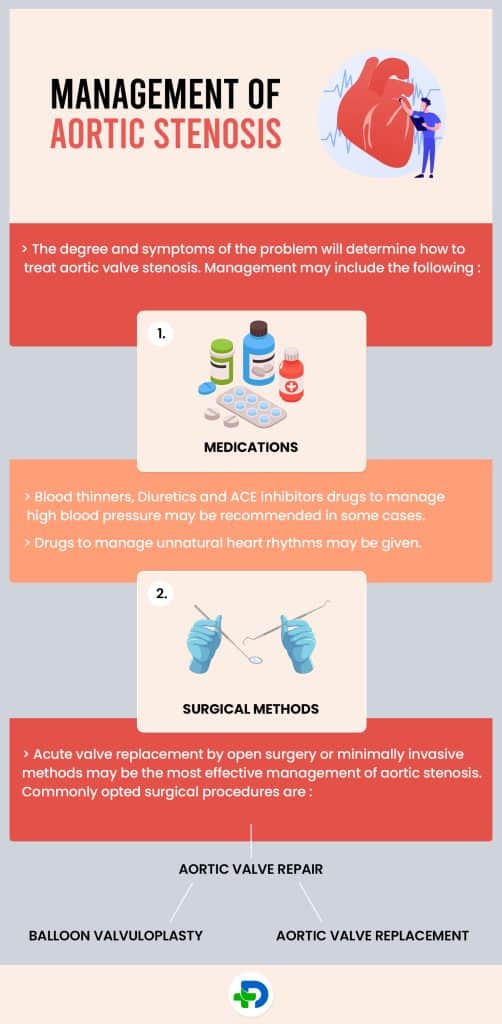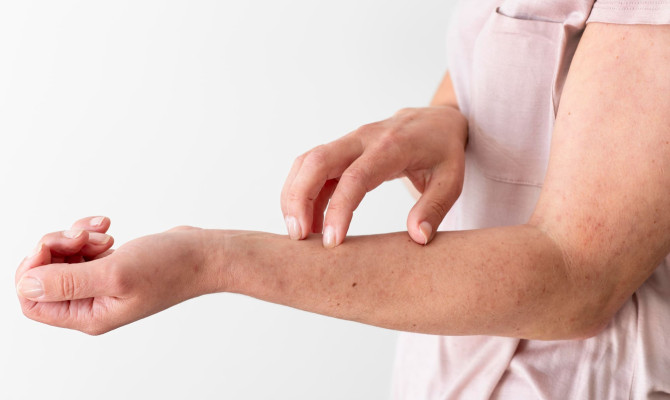Aortic Stenosis : Reasons, Complications, and Management

- Aortic Stenosis
- 14 Aug 2023
Overview
What is Aortic stenosis ?
Aortic stenosis or aortic valve stenosis occurs when the aortic valve in the heart constricts or becomes clogged, thus hindering the heart’s natural ability to pump blood out, and damaging the heart, causing life-threatening complications.
The aorta is the primary artery that collects blood from the heart and distributes it throughout the body. The aortic valve permits blood to leave the heart and pass through the aorta. This valve partially opens or does not open, when there is aortic stenosis, a type of valvular heart disease. As a result, the heart’s blood flow to the aorta and the rest of the body is restricted or reduced. 1What is aortic stenosis? | Researched based study from medlineplus.gov It is more prevalent among the elderly.

Reasons
Reasons
The following are some of the possible reasons for aortic valve stenosis:
Congenital condition
- Bicuspid aortic valves, which have two cusps rather than three (tricuspid), can occasionally be found at birth. 2Reasons | Researched based study from nih.gov
- In some cases, calcification may also be present in addition to the congenital abnormality.
Calcification
- Calcium deposition on the aortic valve may cause aortic valve stenosis.
- In people with congenital valve abnormalities, calcification leads to stiffness of the valve cusps at a young age.
- End-stage renal disease has also been linked to valve calcification.
Rheumatic fever
- If left untreated, infections like scarlet fever or strep throat can lead to rheumatic fever.
- Scar tissue can develop on the aortic valve as a result of rheumatic fever, which can also constrict the opening of the valve or make it so that calcium deposits can build up on its rough surface.
Other conditions
- Aortic valve stenosis may also result from systemic lupus erythematosus, alkaptonuria, radiation exposure, and several other metabolic disorders.
Risk
Risk factors
- Genetic factor – Certain cardiac disorders, such as the bicuspid aortic valve, are present at birth.
- Age – As people age, their risks of developing aortic valve stenosis rise.
- Gender – Men are affected by it more frequently than women.
- Infections – infectious endocarditis and rheumatic fever.
- Chronic diseases – like high blood pressure, diabetes, high cholesterol, and chronic renal disease.
- History of radiation therapy.
Symptoms
Symptoms
From mild to severe, aortic valve stenosis can manifest itself and they may include:
- Problems with short-distance walking
- Palpitations
- A decrease in hunger.
- Spitting blood when coughing.
- Trouble falling asleep while lying flat.
- Foot or ankle swelling.
- Difficulty doing daily tasks
Children and infants with congenital aortic stenosis may display symptoms like:
- Exertion-induced tiredness
- Insufficient or poor dietary intake
- Breathing issues
- Being easily tired after effort (in mild cases)
- Inability to put on weight
Stage
Stages of Aortic valve stenosis
Based on the degree of heart damage, aortic stenosis is staged. 3Stages| Researched based study from ahajournals.org There are four stages, namely:
- Stage A – Patient has a risk may be due to a bicuspid aortic valve.
- Stage B – Progressive stage. Mild to moderate changes in the valve may be there. But there are no symptoms.
- Stage C – Severe stage but asymptomatic. There may be severe valve calcification or reduced opening. But there are no symptoms.
- Stage D – Severe stage with symptoms. Symptoms are caused by severe valve defects with significantly restricted valve movement.
Prevention
Prevention
Aortic stenosis is not completely avoidable in people born with valve defects but some measures can be taken to prevent them like,
- Eat heart healthy food.
- Avoid high-fat and fried food.
- Keep a healthy weight.
- Maintain proper oral hygiene.
- Treating strep throat can help avoid rheumatic fever.
Complications
Complications
Complications of this disease may include:
- Heart failure.
- Stroke.
- Bleeding.
- Arrhythmias. (Irregular heart rhythms)
- Infections like endocarditis.
- Sudden Death.
Diagnosis
Diagnosis
Questions will be asked regarding symptoms and medical history, and then physical examinations and tests will be performed to determine whether the patient has aortic valve stenosis:
Physical examination
- The doctor may use a stethoscope to hear any unusual heart sound.
- It is possible for the neck pulse to be weak or to alter in quality.
- Blood pressure may be low.
Echocardiogram
- Clearly shows how blood travels through the heart’s valves.
- It can also be used to detect weak cardiac muscles and assess the degree of aortic valve stenosis.
Transesophageal echocardiogram (TEE)
- It is a specialized echocardiography used to examine the aortic valve more closely.
Electrocardiogram (ECG or EKG)
- An ECG can display the rate at which the heart beats, as well as patterns that may indicate heart illness or enlargement of the heart’s chambers.
Chest X-ray
- Demonstrates the health of the heart and lungs. It can assist in identifying any cardiac enlargement, which is a potential symptom of aortic valve stenosis. It may also reveal aortic valve calcium deposits and aortic swelling.
Tests of physical exertion or stress
- Assists in identifying if the symptoms appear during physical activity.
Cardiac computerized tomography (CT) scan
- Helps assess the aorta’s size and provides information on the aortic valve.
Cardiac magnetic resonance imaging (MRI) scan
- Used to demonstrate the aorta’s size and to assess how severe aortic valve stenosis is.
Cardiac catheterization
- Done if other tests are unsuccessful in identifying the illness or establishing its severity.
- Used to measure the pressure within the heart chambers and to check for blockages in the coronary arteries, which supply the heart muscle, before aortic valve surgery.
Management

Management of Aortic stenosis
The degree and symptoms of the problem will determine how to treat aortic valve stenosis. Management may include the following:
Medications
- Blood thinners, Diuretics and ACE inhibitors drugs to manage high blood pressure may be recommended in some cases.
- Drugs to manage unnatural heart rhythms may be given.
Surgical methods
Acute valve replacement by open surgery or minimally invasive methods may be the most effective management of aortic stenosis. Commonly opted surgical procedures are:
Aortic valve repair
- Aortic valves are repaired by separating fused valve flaps, or cusps.
- Aortic valve stenosis, in general, requires aortic valve replacement.
Balloon valvuloplasty
- It is a minimally invasive cardiac procedure that involves inserting a tube with a balloon on the tip to open a stiff heart valve. 4Management| Researched based study from nih.gov
- It is not an alternative to valve replacements.
Aortic valve replacement
- The surgeon either replaces the malfunctioning valve with a mechanical or biological tissue valve made from the heart tissue of a pig, cow, or human.
Transcatheter aortic valve replacement (TAVR)
- Serves as an alternative to open cardiac surgery for aortic valve replacement as it is a minimally invasive procedure, necessitating just a tiny skin cut. 5Management| Researched based study from nih.gov
- If a person has a high or moderate risk of experiencing issues from open surgery, this might be an option.
- An aortic valve made of animal tissue is used to replace one that is unhealthy or not functioning properly.
Remedies
Home remedies
Adopting some lifestyle adjustments can protect the heart and may slow or stop heart disease. Try these recommendations for maintaining heart health:
- Avoid smoking.
- Keep a healthy weight.
- Consume heart-healthy foods including fruits, vegetables, chicken, fish, and whole grains.
- Steer clear of too much salt, sugar, saturated, and trans-fat.
- Exercise regularly.
- If symptoms appear, vigorous activities must be restricted.
- Learn techniques for reducing emotional stress like increasing physical activity, engaging in mindfulness, yoga, meditation, etc.
- Obtain routine checkups – to know if the disease is progressive or in check. Take all medications regularly as prescribed.
Outlook
Outlook
The prognosis is very good while the patient is asymptomatic. Sadly, many people are unaware they have it until it produces symptoms, or a screening or diagnostic test reveals it. Within a few years of developing symptoms, mortality increases to over 90%. 6Outlook | Researched based study from Sciencedirect.com A danger of sudden death exists in cases of severe aortic stenosis. The doctor might encourage patients not to put off treatment because of this reason. Aortic valve replacement (AVR) is indicated depending on the severity of the symptoms and it frequently produces very good results. Visiting a facility that frequently performs valve replacement surgeries may get the patient, the greatest care.
Any feedback on this article?
 This Articles content was accurate
This Articles content was accurate Very Informative Article
Very Informative Article I have a question or a comment
I have a question or a comment
 This article contains inaccurate content
This article contains inaccurate content This article was not helpful
This article was not helpful I have a question or a comment
I have a question or a comment
We appreciate your helpful feedback!
Checkout our social pages
References
-
MedlinePlus
Aortic stenosis | Overview
-
National Institutes of Health
Aortic Stenosis | Reasons
-
American Heart Association Journal
Guideline for the Management of Patients With Valvular Heart Disease: A Report of the American College of Cardiology/American Heart Association Joint Committee on Clinical Practice Guidelines
-
National Institutes of Health
Balloon Valvuloplasty | Management
-
National Institutes of Health
Transcatheter Aortic Valve Replacement (TAVR) | Management
-
Science Direct
Natural History, Diagnostic Approaches, and Therapeutic Strategies for Patients With Asymptomatic Severe Aortic Stenosis






































